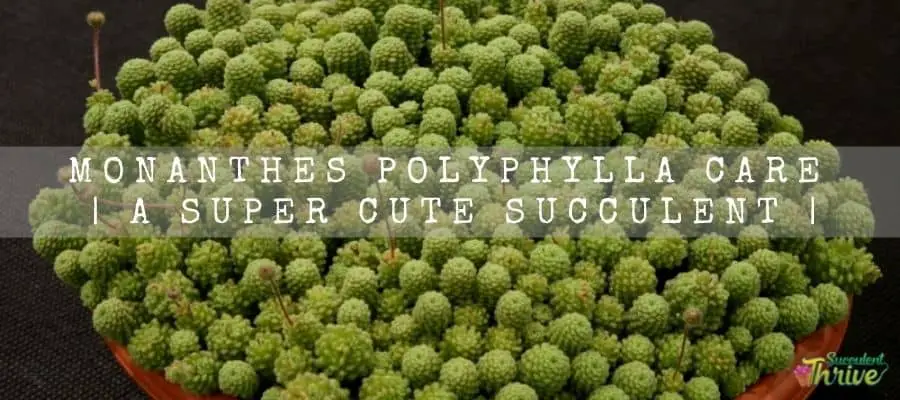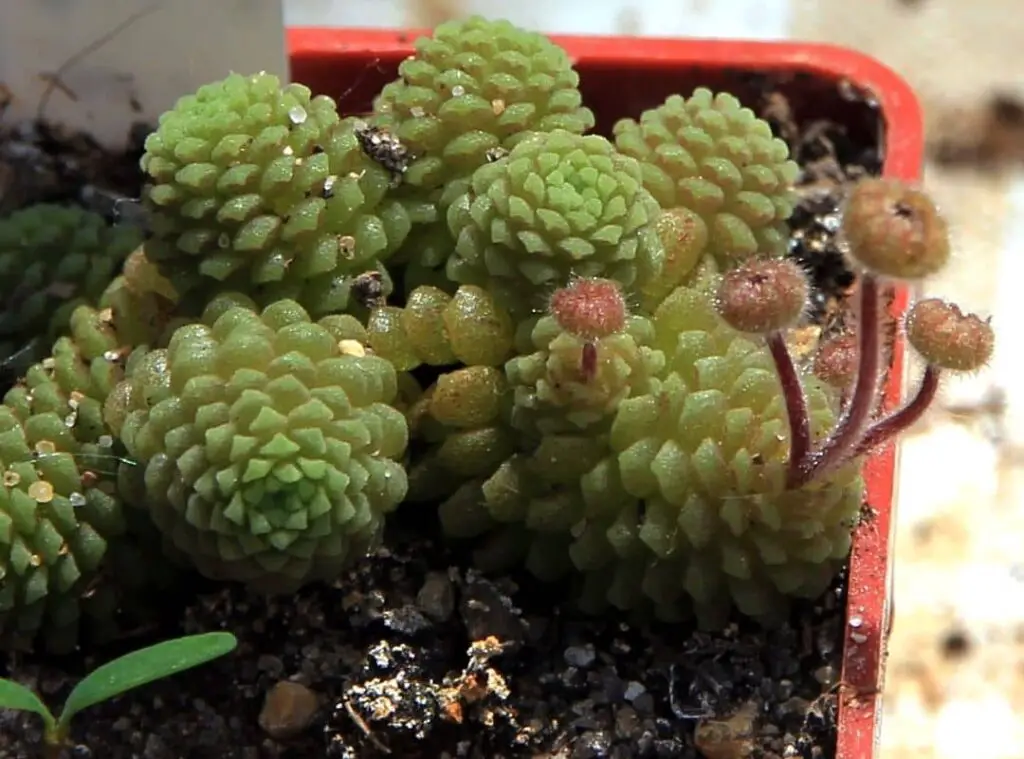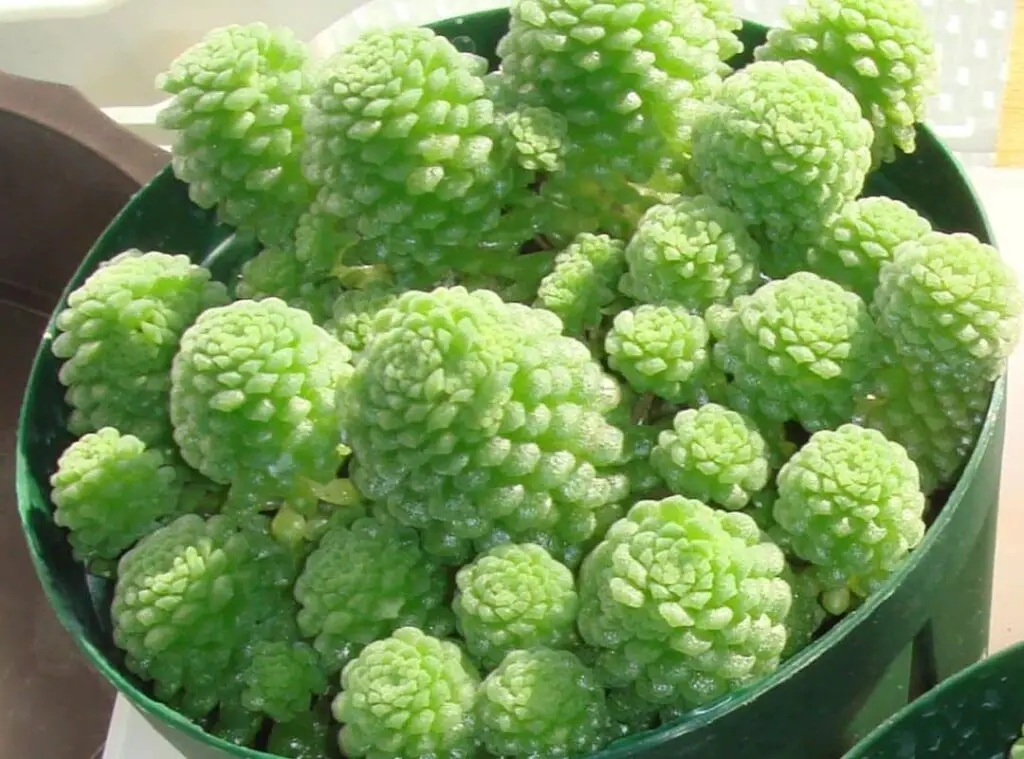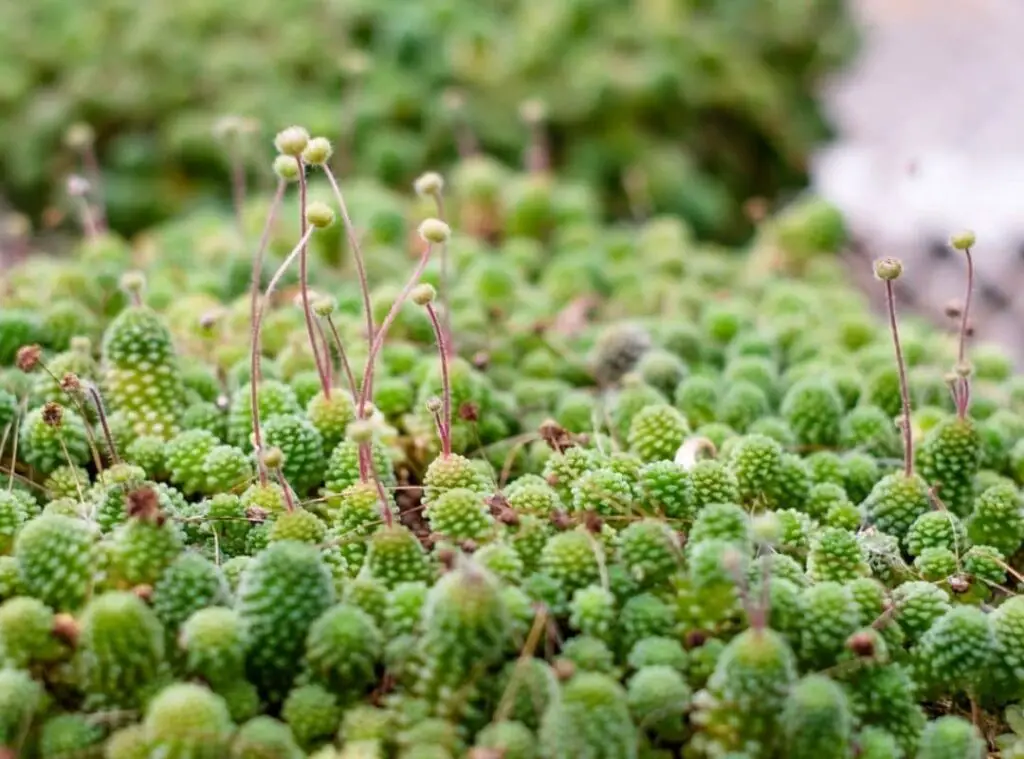Monanthes polyphylla are interesting succulents and they are not as popular as other succulents. But you can find them easily if you know where to find them.
They would usually grow either in clumps or as bushes. Monanthes polyphylla are native plants to the Canary Islands and they belong to the family Crassulaceae.

Monanthes polyphylla would usually grow in high altitudes and their natural habitat would be usually shaded earth cliffs and damp rocks.
Many people like to grow them when they see these beauties. And they require very minimal care.
Further they can thrive well in a small space too. So, the ability to thrive in minimum space is one more reason as to why many people prefer to grow them.
Monanthes polyphylla can resist drought conditions well. They are known as Dwarf Crassula or as one flowered houseleek too.
Monanthes polyphylla is the most attractive species of the Monanthes genus and they have got the name called Monanthes from the Greek Language. Mono literally means one and anthes literally mean flower. On the other hand, Polyphylla literally refers to many leaves.
There are several other Monanthes species such as Monanthes muralis, Monanthes polyphylla Laxiflora and Monanthes brachycaulos etc.
So, let us learn about the Monanthes polyphylla in detail and discover the right care tips you need to practice , the common bugs they may attack, the special care tips you need to practice etc.
How do I identify Monanthes polyphylla?
As aforesaid they would tend to grow either in bushes or in clumps. They would grow up to heights about 4-6 inches.
Monanthes polyphylla are low growing plants and tend to form in creeping manners as well. They have their own unique looks.They form their leaves in rosette shape. They would form on top of the stems.
Monanthes polyphylla leaves would tend to take a gel-like look. Further they could be shiny as well. Their surfaces would look clumpy too.
Monanthes polyphylla leaves would be light green in color. Their stems would be slender and tend to grow in a creeping manner.
They would be 1-2 mm in diameter. The Monanthes polyphylla rosettes would be minuscule. They would further grow densely as well.
The color of the Monanthes polyphylla rossetts would be more like pinkish gray. However, when you cultivate them, it is very unlikely that they will come up with this feature. Instead, they would tend to look in green or purple color only.
To further elaborate on the Monanthes polyphylla leaves, they would be small and soft to the touch. They would tend to take either an obovate or a cylindrical shape.
Those leaves would be 1-2mm in width and 1 mm in thickness. Moreover, you can spot them carrying some hairs on the lower surface of the leaves.
Apart from the above factors, Monanthes polyphylla produce flowers as well. Those flowers would be purple and tend to look like parasols as well.
They are small and would be only 4-9 mm in diameter. Moreover, they would carry 6-9 petals too. You could identify the Monanthes polyphylla from flowering during their flowering season from May to the end of June.
Growth rate
Monanthes polyphylla are slow growing plants. However , they grow at a moderate rate when you cultivate them.
One look care guide
| Botanical Name | Monanthes polyphylla |
| Common Name | Dwarf Crassula or as one flowered houseleek |
| Plant Type | Succulent / cactus |
| Mature Size | maximum height of 2-6 inches |
| Sun Exposure | Full sunlight to filtered sunlight |
| Soil Type | Sandy, well-draining |
| Soil pH | 6 – 7 |
| Bloom Time | May to end June |
| Flower Color | Purple |
| Hardiness Zones | USDA hardiness zones 9-11. |
| Native Area | Canary Islands |
| Average price | $ 15 |

How do you take care of Monanthes polyphylla?
Light Requirement
Monanthes polyphylla would perform well in full sunlight. Hence you may consider growing them outdoors given that they get full sunlight during the morning hours.
However, ensure that you safeguard the plants from intense sunlight during the daytime of the summertime.
Ideally , they need to get filtered sunlight during such harsh times. However, do not grow them under low light also as then there will be bad impacts on the plants.
Further a slightest over watering could also result in root rot. The exposure for filtered sunlight is beneficial for the flower blossom of the Monanthes polyphylla plants.
However, if you accidently expose them to direct sunlight it would result in the scorching of the plants. Further chances are that it could even kill the plants as well. So, best is to avoid exposing them to intense sunrise during summertime.
Temperature and humidity
A temperature range of 65-degree Fahrenheit to 75-degree Fahrenheit would suit them the best. They will prefer to have not too warm and not too cold temperatures right throughout the year.
Is it cold hardy?
The minimum temperature they can stand during winter would be 5-10 degrees Celsius. Having said that, they can withstand some light frost for some time as well.
Zone
Monanthes polyphylla are fond of growing in USDA hardiness zones 9-11.

Watering Requirement
Monanthes polyphylla generally grow in damp rocks and in shaded cliffs. They have a minimal demand in terms of water.
Moderate watering would be sufficient for them to thrive. However, when you water them, you should always allow the soil to wither between two watering sessions and you need to resume watering them only if you ascertain their soil is dry only.
You need to water the Monanthes polyphylla plants in winter only if you witness any shriveling or wrinkled leaves only.
Both Under watering and over watering could be harmful for the wellbeing of the Monanthes polyphylla plants.
However, over watering could create more severe repercussions on them than what under watering does. Simply you can water them regularly during spring to autumn.
When I say regularly, you can water them once every week. It is vital that you water these plants well unless it would badly affect the vigorous growth of them. Further it would make the plants more vulnerable for fungal attacks as well.
Soil Requirement Type / pH
The most crucial factor when selecting a soil mix is to check whether they have excellent drainage. Monanthes polyphylla do not prefer to grow in soggy soil at all.
What many succulent enthusiasts do is that they grow them in commercially made succulent or cactus soil mixes.
Alternatively, they can also thrive well in a soil mix which you could make on your own too. If you wish to do that, simply you need to add ½ commercial potting soil into ½ sand component.
Besides, you may also add pumice which will further enhance the drainage of the soil mix.
Once you stick to these guidelines, it will make sure that your plants have a good drainage as well as a good aeration in the soil mix as well. If you fail to provide a right soil mix, it will lead to root rot.
Pot size Potting and Repotting
A pot which has ample drainage would be beneficial for the Monanthes polyphylla plants’ healthy growth.
Further I recommend growing them in a pot which is high in porosity too. For example, you can go ahead with an unglazed or clay pot for this purpose.
When it comes to repotting the Monanthes polyphylla plants, it is not something which you need to do quite often. Instead, you can do it once every two to three years.
However, when transplanting make sure that you are using a slightly larger pot for them. Besides, make sure that you are not injuring the roots of the Monanthes polyphylla plants as well.
Repotting would allow you to have a closer look on the plant’s roots. In other words, if you could spot any blackened or rotten roots, you can snip them off and treat them with fungicides. In addition to that, it would provide new growing conditions for the plants too.
Where to Plant
You can grow them both indoors and outdoors given that you fulfill their sunlight requirements. However, when you grow them outdoors, make sure that you do not expose them for colder temperatures. .
Fertilizer and time of year
Monanthes polyphylla are drought tolerant plants which literally means they do not have strong requirements in terms of fertilizers.
However , feeding them once or twice a year would be quite useful for them. In fact, it would boost the growth of the plants.
You may use a liquid fertilizer for them. However, ensure what you are using is a diluted liquid fertilizer. Alternatively you may also go ahead with a fertilizer which is low Nitrogen.
Moreover, do not apply any fertilizers during winter as they will be dormant during this period.
Flower
Monanthes polyphylla come up with purple-colored blossoms. You could spot them forming during May to the end of June.

Dormancy
Monanthes polyphylla plants are winter dormant plants.
Other plants Pairs Well With
They would grow well with Haworthia.
Common bugs and illnesses
Monanthes polyphylla may come across attacks from certain pests’ types such as from mealybugs, scales etc.
If you spot any, you can simply wipe them off using a cotton swab which is dipped in alcohol. If not, you can use a toothpick and move them out too.
In addition to aforesaid pests’ attacks, chances are that you may come across Monanthes polyphylla leaves yellowing too.
If you had exposed them to too much sunlight, that would lead to the yellowing of the leaves. To remedy them, you need to shift them to a shady spot.
Healthy Monanthes polyphylla rosettes should grow in a dense manner. So, if you spot any gaps among their leaves, that reflect to you that they are lacking sufficient sunlight levels.
Further it could also be an indication of excessive fertilizing as well. In that circumstance you need to shift them to a bright sunny spot to minimize feeding them.
If you had overwatered the Monanthes polyphylla plants, it could contribute stem rot in the plants. If you spot ant black patches on them, it literally means your precious plants are experiencing a rot.
It is very unlikely that you can revive them if the rot is severe. Ideally what you could do here is to take healthy plant parts and then use them for propagation.
Special Care tips
Monanthes polyphylla do not expect you to do any special grooming or any other maintenance. However, I recommend you remove the dying flowers so that it would make the plants look more pleasant.
How to propagate Monanthes polyphylla?
You can propagate the Monanthes polyphylla by cuttings as well as from division. If you wish to use the cutting method, you need to first obtain them from the parent plants and leave them in a spot where they can wither.
Next when they are dry, you can simply place them in sandy soil which is moistened. After that leave the specimen in a spot where they can gain dappled sunlight.
If you wish to propagate the Monanthes polyphylla through division, all you have to do is to remove the Monanthes polyphylla plants from its pot carefully and then cut the plant into several sections.
Ensure that those divisions carry rosettes and roots. Finally, you can plant them in individual pots where you have added a well-draining cactus or a succulent soil mix. Again, you need to leave it in a place where they can gain filtered sunlight.
Monanthes polyphylla benefits
Monanthes polyphylla would be great picks for indoor gardening. They are handy as ground covers as well. Additionally you may use them in dish gardens too
Besides, the flower blossomed Monanthes polyphylla plants are used for table decoration. When you purchase them from the nurseries, ensure that you are obtaining healthy looking plants so that they could thrive well for a longer time.
Conclusion
Before wrapping this up, Monanthes polyphylla would be such fantastic plants which you can grow indoors as well as outdoors.
If you provide a proper soil mix whilst exposing them for right sunlight levels, they will flourish. It would be such fun to grow them, and you will feel accomplished when you spot them flowering too. So happy cultivating with Monanthes polyphylla!
Read Next : Echeveria Hortencia Care | Astonishingly Beautiful Succulent | Greenovia Pandora | Absolutely Gorgeous |
